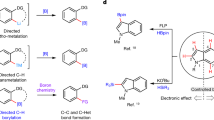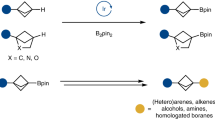Abstract
The design of larger architectures from smaller molecular building blocks by element–element coupling reactions is one of the key concerns of synthetic chemistry, so a number of strategies were developed for this bottom-up approach. A general scheme is the coupling of two elements with opposing polarity or that of two radicals. Here, we show that a B–B coupling reaction is possible between two boron analogues of the ethyl cation, resulting in the formation of an unprecedented dicationic tetraborane. The bonding properties in the rhomboid B4 core of the product can be described as two B–B units connected by three-centre, two-electron bonds, sharing the short diagonal. Our discovery might lead the way to the long sought-after boron chain polymers with a structure similar to the silicon chains in β-SiB3. Moreover, the reaction is a prime textbook example of the influence of multiple-centre bonding on reactivity.
This is a preview of subscription content, access via your institution
Access options
Subscribe to this journal
Receive 12 print issues and online access
$259.00 per year
only $21.58 per issue
Buy this article
- Purchase on Springer Link
- Instant access to full article PDF
Prices may be subject to local taxes which are calculated during checkout

Similar content being viewed by others
References
De Meijere, A. & Diederich, F. Metal-Catalysed Cross-Coupling Reactions 2nd edn (Wiley-VCH, 2008).
Tamao, K. & Miyaura, N. Introduction to cross-coupling reactions. Top. Curr. Chem. 219, 1–9 (2002).
Beller, M. & Zapf, A. The development of efficient catalysts for palladium-catalyzed coupling reactions of aryl halides. Chem. Commun. 2005, 431–440 (2005).
Yin, L. & Liebscher, J. Carbon–carbon coupling reactions catalyzed by heterogeneous palladium catalysts. Chem. Rev. 107, 133–173 (2007).
Molnár, Á. Efficient, selective, and recyclable palladium catalysts in carbon–carbon coupling reactions. Chem. Rev. 111, 2251–2320 (2011).
Osorio, E., Olson, J. K., Tiznado, W. & Boldyrev, A. I. Analysis of why boron avoids sp2 hybridization and classical structures in the BnHn +2 series. Chem. Eur. J. 18, 9677–9681 (2012).
Ciobanu, O. et al. Thermal and catalytic dehydrogenation of the guanidine–borane adducts H3B·hppH (hppH=1,3,4,6,7,8-hexahydro-2H-pyrimido[1,2-a]pyrimidine) and H3B·N(H)C(NMe2)2: a combined experimental and quantum chemical study. Eur. J. Inorg. Chem. 5482–5493 (2008).
Ciobanu, O., Kaifer, E., Enders, M. & Himmel, H-J. Synthesis of a stable B2H5+ analogue by protonation of a double base-stabilized diborane(4). Angew. Chem. Int. Ed. 48, 5538–5541 (2009).
Schulenberg, N., Ciobanu, O., Kaifer, E., Wadepohl, H. & Himmel, H-J. The doubly base-stabilized diborane(4) [HB(μ-hpp)]2 (hpp=1,3,4,6,7,8-hexahydro-2H-pyrimido[1,2-a]pyrimidinate): synthesis by catalytic dehydrogenation and reactions with S8 and disulfides. Eur. J. Inorg. Chem. 5201–5210 (2010).
Braunschweig, H. & Guethlein, F. Transition-metal-catalyzed synthesis of diboranes(4). Angew. Chem. Int. Ed. 50, 12613–12616 (2011).
Braunschweig, H., Claes, C. & Guethlein, F. Dehydrocoupling of catecholborane catalyzed by group 4 compounds. J. Organomet. Chem. 706–707, 144–145 (2012).
Wagner, A., Kaifer, E. & Himmel, H-J. Diborane(4)–metal bonding: between hydrogen bridges and frustrated oxidative addition. Chem. Commun. 48, 5277–5279 (2012).
Dureen, M. A., Lough, A., Gilbert, T. M. & Stephan, D. W. B–H activation by frustrated Lewis pairs: borenium or boryl phosphonium cation? Chem. Commun. 4303–4305 (2008).
DeVries, T. S. & Vedejs, E. Electrophilic activation of Lewis base complexes of borane with trityl tetrakis(pentafluorophenyl)borate. Organometallics 26, 3079–3081 (2007).
Wang, P. & Vidal, C. R. Dissociation of multiply ionized alkanes from methane to n-butane due to electron impact. Chem. Phys. 280, 309–329 (2002).
Price, W. S. NMR Studies of Translational Motion, Principles and Applications (Cambridge Univ. Press, 2009).
Evans, R. et al. Quantitative interpretation of diffusion-ordered NMR spectra: can we rationalize small molecule diffusion coefficients? Angew. Chem. Int. Ed. 52, 3199–3202 (2013).
Maier, A., Hofmann, M., Pritzkow, H. & Siebert, W. A planar, aromatic bicyclo-tetraborane(4). Angew. Chem. Int. Ed. 41, 1529–1532 (2002).
Präsang, C., Hofmann, M., Geiseler, G., Massa, W. & Berndt, A. Aromatic boranes with planar-tetracoordinate boron atoms and very short B–B distances. Angew. Chem. Int. Ed. 41, 1526–1529 (2002).
Präsang, C. et al. A. Two-electron aromatics containing three and four adjacent boron atoms. Pure Appl. Chem. 75, 1175–1182 (2003).
Pardoe, J. A. J. et al. The surprising structures of B8F12 and B10F12 . Angew. Chem. Int. Ed. 42, 571–573 (2003).
Balakrishnarajan, M. M. & Hoffmann, R. Electron-deficient bonding in rhomboid rings. J. Am. Chem. Soc. 126, 13119–13131 (2004).
Koch, W. et al. Structures, stabilities, and bonding in CBe2, C2Be, and C2Be2 . J. Am. Chem. Soc. 108, 5732–5737 (1986).
Kameda, M. & Kodama, G. Cleavage reaction of pentaborane(9). Formation of a new hypho triborane adduct. Inorg. Chem. 19, 2288–2292 (1980).
Piers, W. E., Bourke, S. C. & Conroy, K. D. Borinium, borenium, and boronium ions: synthesis, reactivity, and applications. Angew. Chem. Int. Ed. 44, 5016–5036 (2005).
Kinjo, R., Donnadieu, B., Celik, M. A., Frenking, G. & Bertrand, G. Synthesis and characterization of a neutral tricoordinate organoboron isoelectronic with amines. Science 333, 610–613 (2011).
Vidovic, D., Findlater, M. & Cowley, A. H. A β-diketiminate-supported boron dication. J. Am. Chem. Soc. 129, 8436–8437 (2007).
Braunschweig, H. et al. Synthesis and structure of a ferrocenyl boron dication. Inorg. Chem. 47, 7456–7458 (2008).
Dinda, R. et al. Synthesis and structural characterization of a stable dimeric boron(II) dication. Angew. Chem. Int. Ed. 46, 9110–9113 (2007).
Braunschweig, H. et al. A. Controlled homocatenation of boron on a transition metal. Nature Chem. 4, 563–567 (2012).
Braunschweig, H. & Dewhurst, R. D. Single, double, triple bonds and chains: the formation of electron-precise B–B bonds. Angew. Chem. Int. Ed. 52, 3574–3583 (2013).
TURBOMOLE version 6.1 (University of Karlsruhe and Forschungszentrum Karlsruhe GmbH, 2009); www.turbomole.com
Lu, T. Multiwfn: A Multifunctional Wavefunction Analyser version 2.6.1; http://multiwfn.codeplex.com/releases/view/97295
DENZO-SMN Data processing software, Nonius (1998); http://www.nonius.nl
Sheldrick, G. M. SHELXS-97: Program for Crystal Structure Solution (Univ. Göttingen, 1997); http://shelx.uni-ac.gwdg.de/SHELX/index.php
Sheldrick, G. M. SHELXL-97: Program for Crystal Structure Refinement (Univ. Göttingen, 1997); http://shelx.uni-ac.gwdg.de/SHELX/index.php
Ibers, J. A. & Hamilton, W. C. International Tables for X-ray Crystallography Vol. 4 (Kynoch Press, 1974).
Zsolnai, L. & Huttner, G. XPMA (Univ. Heidelberg, 1994); http://www.uni-heidelberg.de/institute/fak12/AC/huttner/software/software.html
Acknowledgements
The authors thank W. Siebert for discussions and the Deutsche Forschungsgemeinschaft (DFG) for continuous financial support.
Author information
Authors and Affiliations
Contributions
H-J.H. conceived and supervised the study. S.L. performed the syntheses and the computational experiments. E.K. performed the X-ray crystallographic measurements. M.E. performed the DOSY-NMR measurements. S.L. and M.E. analysed the data and co-wrote the paper.
Corresponding author
Ethics declarations
Competing interests
The authors declare no competing financial interests.
Supplementary information
Supplementary information
Supplementary information (PDF 973 kb)
Supplementary information
Crystallographic data for compound 3[HB(C6F5)3]2. (CIF 69 kb)
Rights and permissions
About this article
Cite this article
Litters, S., Kaifer, E., Enders, M. et al. A boron–boron coupling reaction between two ethyl cation analogues. Nature Chem 5, 1029–1034 (2013). https://doi.org/10.1038/nchem.1776
Received:
Accepted:
Published:
Issue Date:
DOI: https://doi.org/10.1038/nchem.1776
This article is cited by
-
Cationic cluster formation versus disproportionation of low-valent indium and gallium complexes of 2,2’-bipyridine
Nature Communications (2015)
-
A two-coordinate boron cation featuring C–B+–C bonding
Nature Chemistry (2014)





